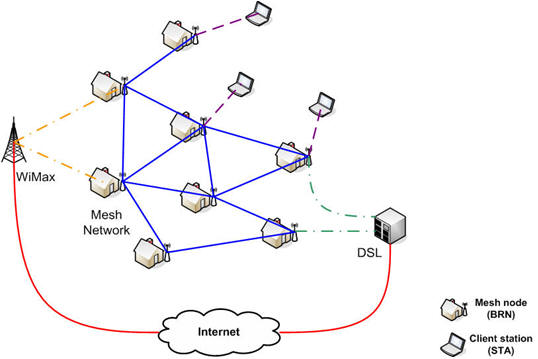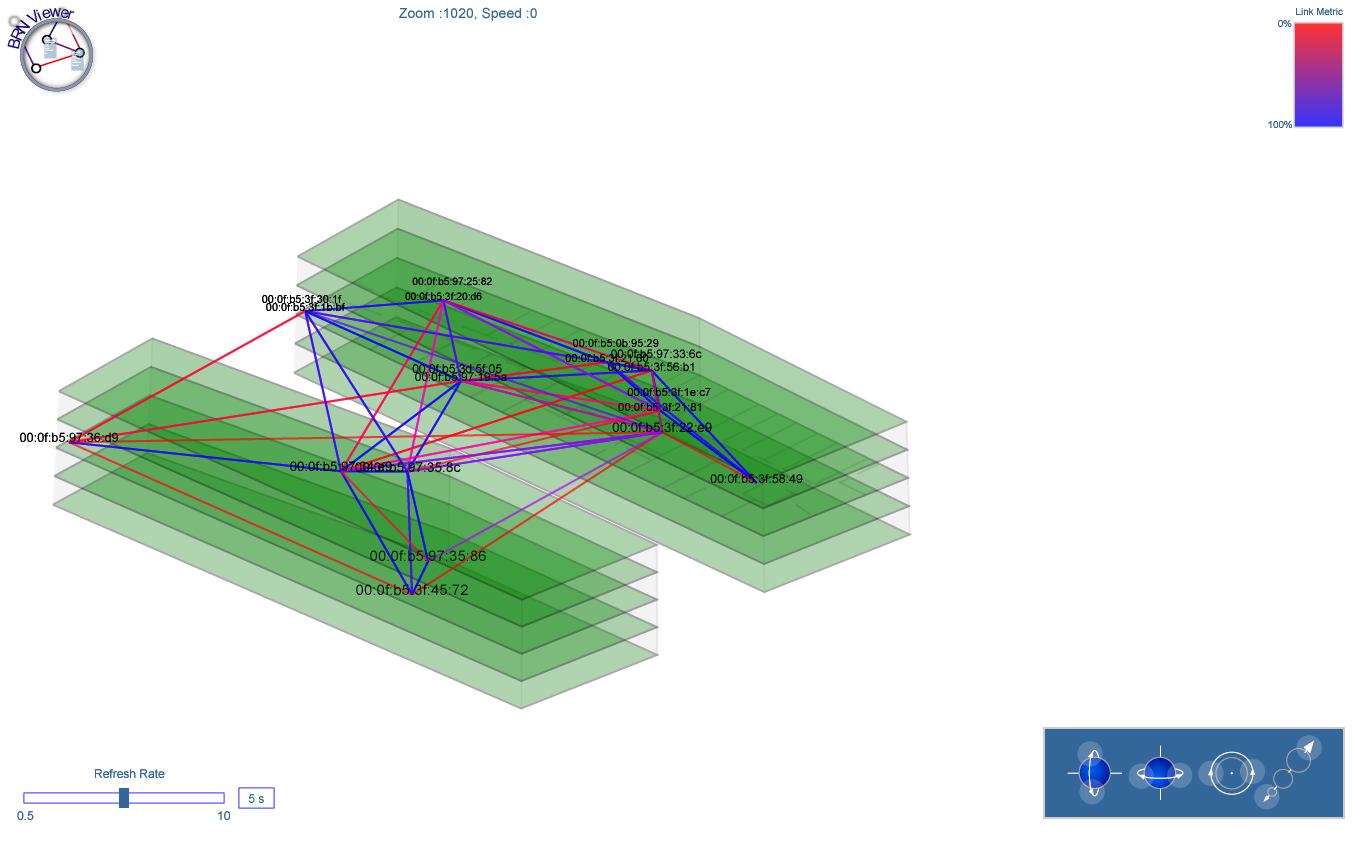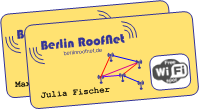BerlinRoofNet: Difference between revisions
No edit summary |
No edit summary |
||
| (33 intermediate revisions by 3 users not shown) | |||
| Line 1: | Line 1: | ||
The [http://www.pdos.lcs.mit.edu/roofnet/ MIT Roof Net project] has demonstrated that it is possible to |
Wireless multi-hop mesh networks play an increasingly important role as backbones for sensor networks and as community networks that provide Internet access in urban areas. The [http://www.pdos.lcs.mit.edu/roofnet/ MIT Roof Net project] has demonstrated that it is possible to supply a large city, such as Boston, with IP network access over an 802.11-based wireless mesh network. The Berlin Roof Net project investigates if a similar (even larger) network can be setup in the city of Berlin and whether such a network can be build in a completely self-organizing/self-configuring way. The Berlin Roof Net project is run by volunteer students of the Computer Science Department at Humboldt University Berlin. Mesh nodes are run independently by the students with their own equipment. |
||
<span style="color:#FF0000"><b>News:</b> Berlin RoofNet goes Open Source.</span> |
|||
The Boston network consists of approximately 40 nodes that are mounted on the roofs of buildings (hence the name ’roof net’) and is operated by students and other volunteers. RoofNet nodes discover each other automatically and create a mesh network, which, with the help of proper routing protocols, allow for transmission of IP packets between any two nodes of the network, with data rates of about 1Mbps. |
|||
All sources are accessible via [http://sartrac.informatik.hu-berlin.de/brn SarTrac]. |
|||
[[Image:-Mesh.png|thumb|Mesh Network]] |
|||
Berlin has unique properties that make the establishment of such a roof network challenging: |
|||
===Vision=== |
|||
A community network must be usable for inexperienced end users; thus self-organization is essential. On the one hand, we are working on protocols for ad-hoc wireless multi hop mesh networks, where the client is fully freed from such mundane tasks as IP configuration, etc. On the other hand, the community mesh network itself shall be fully self-organized thus no operator or provider is required. |
|||
Realizing a wireless mesh network turns out to be non-trivial. One of their biggest challenges is the insufficient scalability with increasing number of nodes and users. The most important reason for this phenomenon can be found in the structure of a multi-hop network: a node is responsible not only for the transmission of its own data, but also for forwarding packets of other nodes. No less significant is the fact that wireless network nodes in close proximity interfere with each other because they share the same medium. With the help of our Berlin RoofNet testbed we can develop, test and evaluate new routing protocols for wireless multi-hop mesh networks. |
|||
* Berlin has generally higher buildings with more metal structures than Boston. |
|||
* Distances between project participants tend to be larger in Berlin than in Boston. |
|||
* It is yet unknown whether the mounting of RoofNet nodes/antennas on buildings is practicable in Berlin. |
|||
* Radio interference may be more intense in Berlin due to more systems that are simultaneously operated at 2.4 GHz. |
|||
* The acceptance of radio-based communication by the general public may be less pronounced in Berlin than in Boston. |
|||
[[Image:Brnviewer.png|thumb|BRN Realtime Map]] |
|||
==Overview== |
===Overview=== |
||
| ⚫ | |||
[[MSC Tracer for BRN|Tools]] |
|||
[[Project Status|Project Status]] |
[[Project Status|Project Status]] |
||
[[BRN |
[[BRN-Development|Software]] |
||
[[BRN-Hardware|Hardware]] |
|||
==Thesis Proposals== |
|||
[[Brn.Sim|Brn.Sim Simulation Tools]] |
|||
See [http://sar.informatik.hu-berlin.de/research/thesis_proposals.htm] for a list of currently available thesis proposals that are related to the Berlin Roof Net project. |
|||
| ⚫ | |||
See [[BRN Sub Projects]] for current (ongoing) thesis work/projects. |
|||
[[BRN Thesis Proposals|Thesis Proposals]] |
|||
[[BRN Further Info|Further Information]] |
|||
[[BRN Other|Other]] |
|||
Technical Papers: |
|||
[[BRN FAQ|FAQ]] |
|||
* [[Programming the Linksys WRT54GS Wireless Broadband Router]] (Tutorial) |
|||
* [[:Image:WiMax-LOS.pdf|WiMax's technology for LOS and NLOS environments]] (pdf) |
|||
* [[Using StandardizedDevelopmentEnvironment|Using Standardized Development Environment for OpenWRT]] (Tutorial) |
|||
* [[Upgrading the Linksys WRT54GS antenna]] |
|||
* [[Hacking the Netgear wgt634u]] (obsolete) / [[BRN:Software:Build and Distribution]] (WiP) |
|||
* [[OpenWGT]] http://openwgt.informatik.hu-berlin.de/ |
|||
* [[How to share your internet access]] |
|||
Known Hardware: |
|||
* [[BRN:Hardware:WPNT843 Netgear WPNT834 (uses MIMO)]] |
|||
* [http://www.meshnode.org Meshnode] |
|||
* [http://www.routerboard.com/rb500.html alternative Hardware RouterBOARD 532A] |
|||
General Press: |
|||
* [http://news.zdnet.co.uk/communications/wireless/0,39020348,39189953,00.htm Intel has unveiled proposal for 802.11s, a new mesh wireless networking standard]. ZDNet UK, Mach 2005 ([[:Image:802_11s.pdf|cached pdf]]) |
|||
* [http://www.spiegel.de/netzwelt/technologie/0,1518,344668,00.html Utopien aus Sauerkrautdosen]. Spiegel (German), March 2005. ([[:Image:UtopienAusSauerkrautdosen.pdf|cached pdf]]) |
|||
* [http://www.spiegel.de/netzwelt/netzkultur/0,1518,344502,00.html Breitband zwischen Deich und Düne]. Spiegel (German), March 2005. ([[:Image:BreitbandZwischenDeichUndDüne.pdf|cached pdf]]) |
|||
* [http://www.ndrtv.de/ratgebertechnik/themen/20060218_dsl_alternativen.html DSL-Alternativen – Schnelles Internet per Satellit und Funk]. NDR (German), February 2006. ([[:Image:DSL-Alternativen.pdf|cached pdf]]) |
|||
Similar projects in other cities: |
|||
* [http://www.pdos.lcs.mit.edu/roofnet/ MIT RoofNet in Boston] |
|||
* [http://www.nycwireless.net/ New York Wireless] |
|||
* [http://www.austinwireless.net/ Austin Wireless] |
|||
* [http://www.seattlewireless.net/ Seattle Wireless] |
|||
* http://wavelan-berlin.de -- Freies Netz in Berlin |
|||
* http://freifunk.net -- Freie (Wlan)Netze in Dtl., Österreich und der Schweiz |
|||
* http://www.funkfeuer.at/ -- Freies Netz in Wien |
|||
* [http://www.wlanhain.de/technik1.html WlanHain (Wireless LAN in Berlin Friedrichshain)] |
|||
* [http://www.wlanhsh.de/ WlanHSH (Wireless LAN in Berlin Hohenschönhausen / Weißensee)] |
|||
* [http://degnet-wdsl.de/ wireless DSL in Niederbayern] |
|||
Related Projects: |
|||
* [[ClickModularRouter|Click Modular Router]] |
|||
[[Licensing Policy]] |
|||
Working Groups |
|||
* [http://research.microsoft.com/mesh/ Microsoft Mesh] |
|||
* [http://www.intel.com/research/exploratory/motes.htm Intel Mote (Self-Organizing Sensor Networks)] |
|||
[[Image:BrnLogo2.png|thumb|Berlin RoofNet]] |
|||
Other: |
|||
* [[BrnHistory|Berlin Roof Net History]] |
|||
* [http://www.meshcom.com/ Meshcom] |
|||
* [http://www.linux-magazin.de/Service/Books/Buecher/HW-Treiber/x19513.html Die Struktur net_device im Detail] |
|||
== |
===Contact=== |
||
Further information about BerlinRoofNet Project can be found here [http://www.berlinroofnet.de/ BRN Testbed]. |
|||
* BRN-Doxygen [http://nfs-student/doxygen/click/] |
|||
If you have any questions please write us an e-mail to zubow@informatik.hu-berlin.de. |
|||
* BugZilla [http://wiki/cgi-bin/bugzilla/index.cgi] |
|||
* Click-Tutorials [http://www.pats.ua.ac.be/index.php?id=software] |
|||
* [[BRN:OpenWrt:Files]] |
|||
Latest revision as of 08:08, 18 November 2010
Wireless multi-hop mesh networks play an increasingly important role as backbones for sensor networks and as community networks that provide Internet access in urban areas. The MIT Roof Net project has demonstrated that it is possible to supply a large city, such as Boston, with IP network access over an 802.11-based wireless mesh network. The Berlin Roof Net project investigates if a similar (even larger) network can be setup in the city of Berlin and whether such a network can be build in a completely self-organizing/self-configuring way. The Berlin Roof Net project is run by volunteer students of the Computer Science Department at Humboldt University Berlin. Mesh nodes are run independently by the students with their own equipment.
News: Berlin RoofNet goes Open Source. All sources are accessible via SarTrac.
Vision
A community network must be usable for inexperienced end users; thus self-organization is essential. On the one hand, we are working on protocols for ad-hoc wireless multi hop mesh networks, where the client is fully freed from such mundane tasks as IP configuration, etc. On the other hand, the community mesh network itself shall be fully self-organized thus no operator or provider is required.
Realizing a wireless mesh network turns out to be non-trivial. One of their biggest challenges is the insufficient scalability with increasing number of nodes and users. The most important reason for this phenomenon can be found in the structure of a multi-hop network: a node is responsible not only for the transmission of its own data, but also for forwarding packets of other nodes. No less significant is the fact that wireless network nodes in close proximity interfere with each other because they share the same medium. With the help of our Berlin RoofNet testbed we can develop, test and evaluate new routing protocols for wireless multi-hop mesh networks.
Overview
Contact
Further information about BerlinRoofNet Project can be found here BRN Testbed. If you have any questions please write us an e-mail to zubow@informatik.hu-berlin.de.


